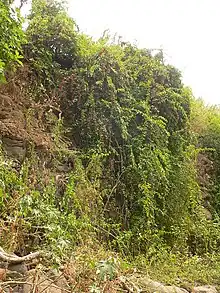Bosea (plant)
Bosea is a genus of evergreen, woody shrubs contains 3 species that are geographically widely separated; one in the Canary Islands, one in Cyprus and one in the western Himalayas.[1] The species have many crowded cane-like stems from ground level grow to medium to tall shrubs, smallish simple leaves with smooth margins, and tiny white-to-green flowers in branched spikes at end of branches. The fruits are small berries, which have varied local uses as food plants and in traditional medicine.
| Bosea | |
|---|---|
 | |
| Bosea yervamora | |
| Scientific classification | |
| Kingdom: | Plantae |
| Clade: | Tracheophytes |
| Clade: | Angiosperms |
| Clade: | Eudicots |
| Order: | Caryophyllales |
| Family: | Amaranthaceae |
| Subfamily: | Amaranthoideae |
| Genus: | Bosea L. |
| Species | |
|
See text | |
Cultivation
Although rarely found in cultivation they are easily grown in any well-drained soil in full sun or warm sheltered position in climates from cool temperate to temperate. They re-sprout vigorously after being cut back and can be grown as an ornamental or informal kind of hedge. They can be propagated from cuttings, seed or root division.[2][3]
References
- Iamonico, D. (2013, December). Lectotypification of the Linnaean name Bosea yervamora (Amaranthaceae). Anales del Jardin Botanico de Madrid Vol. 70, No. 2, pp. 187-188.
-
- Ellison, D. (1995). Cultivated Plants of the World. London: New Holland. 1st ed.: Brisbane: Flora Publications International.
- Lord, T. (2003). Flora : The Gardener's Bible : More than 20,000 garden plants from around the world. London: Cassell. ISBN 0-304-36435-5